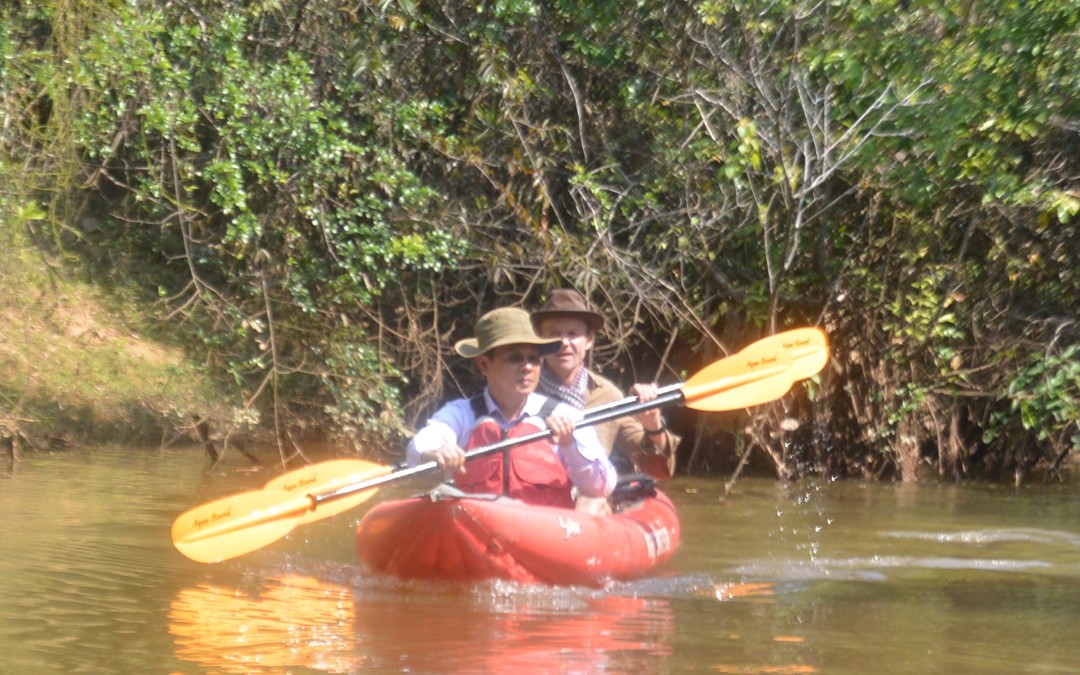
by Nick | Jul 8, 2020 | Angkor, Blog, Kayak
Background
The rise and fall of the Angkorian Empire, which lasted 500 years from the 9th to 14th century, was centered in what is now Siem Reap Province, around its greatest monument Angkor Wat. A population of a million in an area of 1000 km2 serviced the empire and built the religious structures the remnants of which we see today.
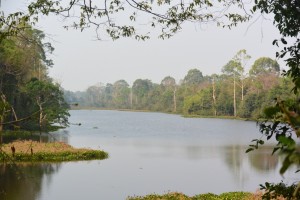 Angkor Wat Moat
Angkor Wat Moat
Key to the success of the civilization was the management of water in a region of inundation and drought. An elaborate system of canals and barays or reservoirs channeled water from the Kulen Hills to the North into the city.
The availability of water ensured that food went in and shit went out. Canals facilitated the construction of the temples conveying the stone from the quarries to the North. And the temples were built with defensive moats that maintained ground water levels preventing their subsidence.
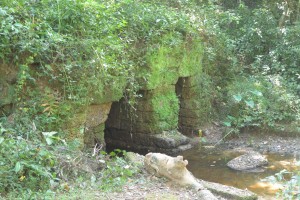 Runta Dev, the tunnel under the 8m high walls of Angkor Thom that channeled waste-water into the moat
Runta Dev, the tunnel under the 8m high walls of Angkor Thom that channeled waste-water into the moat
It is now thought that the decline in management and maintenance of the hydrology coincided with that of the empire.
In recent years the importance of these systems has been recognized again as the massive increase in tourism has lead to ground water levels falling and the potential collapse of the temples. It is no coincidence that the best preserved are those with functioning moats.
One man has been championing the restoration of the Angkorian water management. He has overseen the construction of canals that channel the Siem Reap River into the North Baray, the moats of Preah Khan, Ankgor Thom and even Angkor Wat. Reducing the possibility of Siem Reap flooding as it did in 2011, while maintaining ground water levels and preventing the temples falling down.
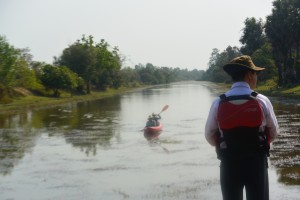 Overseeing our progress up the North Baray Channel
Overseeing our progress up the North Baray Channel
These small matters aside obviously the most important function of Angkorian hydrology is to allow us to paddle through the Angkor Park, Cambodia’s best preserved 400 km2 of lowland mixed evergreen and deciduous forest.
And so it was one Monday morning that his excellency the Director of Water Management at Apsara and now Director General, facilitated by Jady together with Buntha and myself kayaked through the heart of a Unesco declared world heritage site. Jady and I had previously recced Peou’s canal that diverts the flow from Siem Reap into the North Baray and round to the West Baray. This time we didn’t get lost and anyway Peou knew the way, but – we hadn’t followed the river as it heads South towards the Tonle Sap Lake.
The current had cut deep into the soft ground leaving 7meter high banks that we had to scramble down with our kayaks and then awkwardly get in them.
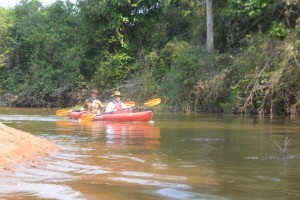 Paddling down the Siem Reap River
Paddling down the Siem Reap River
A few fallen branches had accumulated enough flotsam and jetsam to block the river with no way through but a messy scramble. Jady and Buntha paved the way. Poeu and I made it easy.
There are 700 Angkorian structures inside the Angkor Park but only 180 of them can be called temples, they’re the ones with moats. These monumental stone edifices need solid ground for their structural integrity, without it they crumble to a pile of stones. Siem Reap is a built on a light sandy soil, water gives it substance, which is what the moats do for the temples.
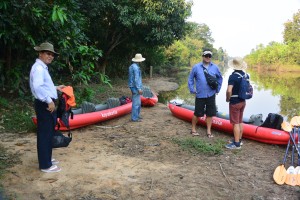 Contemplating our adventure
Contemplating our adventure
A few hundred meters on either side there were no doubt bus loads of Asian tourists but here in the heart of Angkor we paddled passed explosions of bamboo erupting on either side. White-collared Kingfishers taunted Buntha to catch a photo. A Snake Eagle followed our progress from above, while a Shikra watched us with disinterest from a fallen branch. All manner of other birds sang from the trees on either side obliterating any thoughts of tourists or even other people.
We’d catered for 5 pax kayaking but one of the water management guys came along for the ride so the third kayak was one paddle power short and we had visions of Kosal, Jady’s assistant unable to move his shoulders for a month or 2. They’d had the sense to share the work and caught up beaming and claiming the big adventure.
Our driver had accumulated helpers by the time we reached the sluice gates at the French Bridge (confusingly built by Americans), who pulled us up the steep stairs to Jady’s vehicle.
It took a while to sink in that we had paddled through one of the wonders of the world, visited by 3 million people but seen none, instead thick riparian forest as if we were discovering it for the first time.
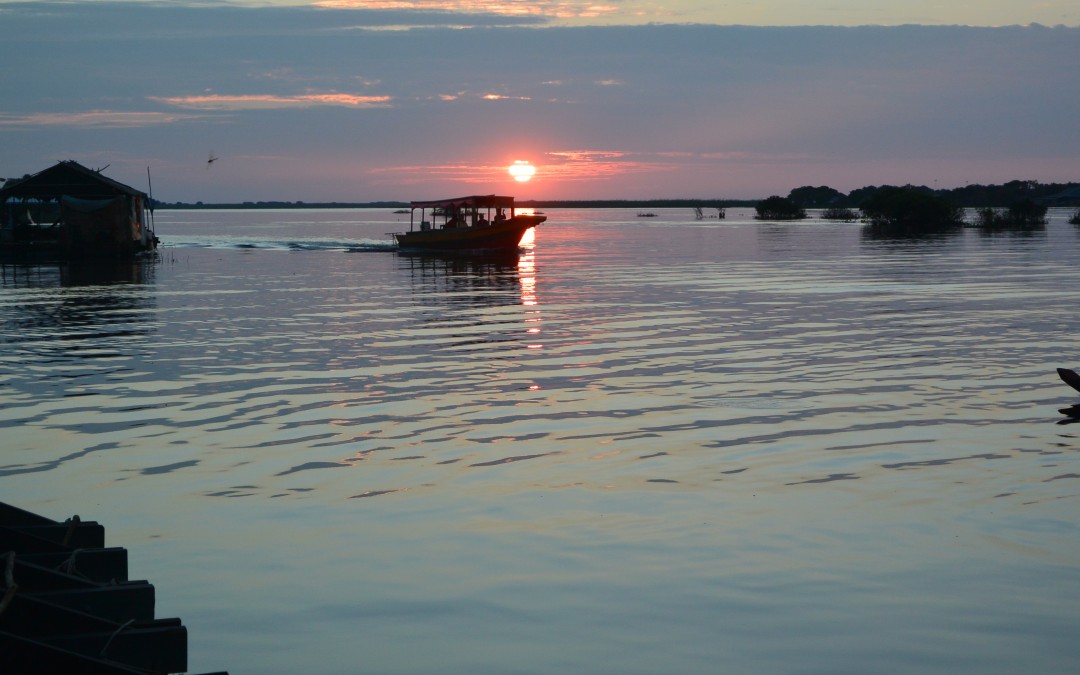
by Nick | Apr 2, 2020 | Blog, Cambodian Journeys, Conservation, Culture, Kayak, Uncategorized
Lena & Seb’s Battambang Adventure
Day 1
Vans, big motorboats, little motorboats, kayaks, bicycles, trains and taxis all had a part to play in our adventure on route from Siem Reap to Battambang. Overnight in the floating village of Prek Toal and the flooded forests of the Core Bird Reserve. Across the floodplains of the Tonle Sap Great Lake and up the Sangke River through the lush rural countryside of Battambang Province to the centre of the farming town in twenty four hours and a bit.
The expedition started at the boat station near Maichrey floating village, where Mr Heang and Finfoot, our comfortably converted fishing boat were waiting. The water was still high enough for us to cross the flooded scrub where we moored to a submerged tree. Lena and Seb were apt pupils as I explained the hydrological phenomena of the Mekong River system until I was rudely interrupted by a virulent green pit viper wrapped around a branch overhanging the deck.
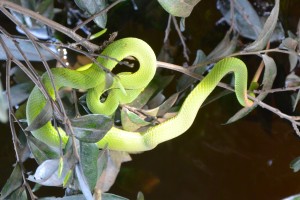 Pit Viper in tree beside boat
Pit Viper in tree beside boat
The afternoons adventure was to explore Prek Toal floating village and the surrounding flooded countryside by kayak. The police chief took photos as we paddled past his station, children came out to stare as we floated by their houses, while those who were working ignored us.
Our improvised route went between the blackened trunks of flooded trees, under their dense green canopy and emerged beside the floating Catholic Church. We crossed the channel to where a muscled boy was ladling fish into piles in front of squatting ladies who chopped them up with meat cleavers, making a pulp that would ferment into Prahoc or Khmer cheese. So named because it stinks.
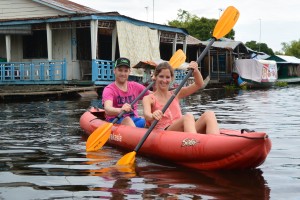 Seb and Lena setting off from their homestay
Seb and Lena setting off from their homestay
We watched the sun – a blood red orange, set over the Core Bird Reserve from the watchtower on top of the environmental research station, then motored over to the Saray Platform for supper.
 Sunset over the Prek Toal Core Bird reserve
Sunset over the Prek Toal Core Bird reserve
Reflections twisted by the wake of motorboats, a cool breeze playing over the boat’s spume.
Hosing the prahok tables ready for tomorrow. Alien clumps of hyacinth drifting on the water.
Single pin pot lights overly bright in the blackness.
Cotton wool fluff of half seen cloud and the glare of a television set as we came close to people’s houses.
The women weavers on the water hyacinth workshop had gone home but their piers were cooking us a supper of fish, vegetables and fruit with rice and a good bottle of chardonnay to wash it down.
Swinging in a hammock in Veasna’s house our home for the night. Manus hid a lime in Baby Buntha’s nappy. His sister heaved the heavy little lump across the floor. The Mother in Law busied herself with not much. The Grandmother on all fours played with the baby. Little sister went skipping to her mummy then wrapped the baby in plastic, all the while pool hall play by the lads in the village. Hide and seek by the water jar, doubled up Grandmother.
Day 2
Streaky orange lighting the village as the first long tails cacaphonic clatter echoed across the water, the old lady hawked, the batteries ran out on the night lanterns. We awkwardly crossed the tilting boats to the pool hall barge to meet Heang, who took us for breakfast back at the Saray Platform.
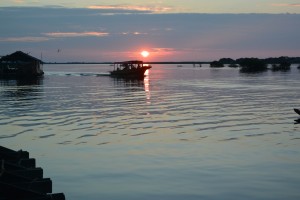 Dawn over Prek Toal
Dawn over Prek Toal
Bunhoeurn was waiting in the community boat for the ride into the magical landscape of the post dawn flooded forest. The light of the warming sun reflected by the delicate yellow flowers of floating saray plants. Squadrons of cormorants flew in slip-stream formation. A profusion of black and white; Oriental darters mixed with egrets, pelicans riding the thermals like galleons in the sky and the bird colonies. Avian cities built in the tallest trees.
Back in the village by 9am our journey into the heart of darkness (actually lush, pastoral Battambang) began.
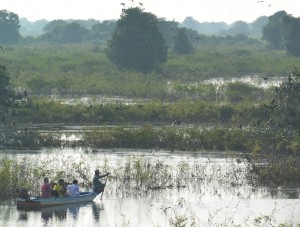
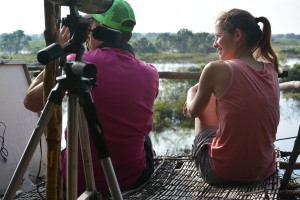
The core bird reserve & view from observation platform
The waterway was fringed by hyacinth and undulating green margins of scrub with the occasional hamlets of floating houses or shacks tied to trees. The first proper village was Kampong Prahoc, which sort of translates into waterside place of good fermented fish paste. I wouldn’t want to be there when the water is low and rotten fish undiluted!
After an hour or so we began to get an idea of how vast the floodplain is. Over 40 kilometres wide where the water rises and falls by 10 meters submerging all but the tallest trees. In the floating villages along our route the only permanent constructions were pagodas on stilts.
Around a bend and Wat Cheu Khmao or temple of the black wood, came into view like a Burmese monastery with a beautiful modern pagoda framed by sugar palms behind. It was built in 1944 copying the Bayon Temple in Angkor and completed with Loksvara, the smiling faces at the cardinal points but they were blamed after accidents and disease struck the village then removed.
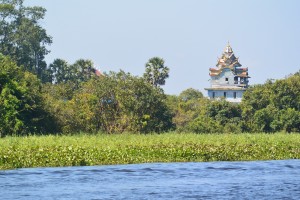 The salapali or space for teaching of Wat Cheu Kmao
The salapali or space for teaching of Wat Cheu Kmao
Great clumps of yellow green bamboo towered over the floating houses. The stems are harvested to provide the floating platforms on which the villages are built.
A regal Grey-headed fish eagle on guard beside its nest in a tall tree, while on a lower branch a hunched up night heron the servile vizier to the magnificent bird above.
We passed a tacky tourist lunch stop as bad as any bus station for the back packers crammed inside and on top of the fibreglass tourist boat.
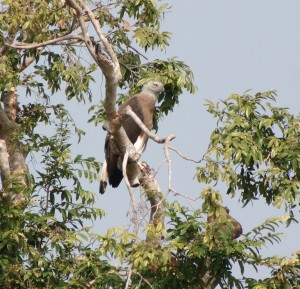 Grey-headed Fish Eagle
Grey-headed Fish Eagle
A single file short cut through the scrub, stopping for long tail boats loaded with beer and rice and wooden boats with giant water jars. We emerged onto an open plain where the trees had been cut down. Home to a transient people living on their small house-boats or shelters on the river bank as the water receded. Strange pivoting bamboo fishing nets were lowered into the water then raised revealing a whicker basket tied to the bottom to trap the fish.
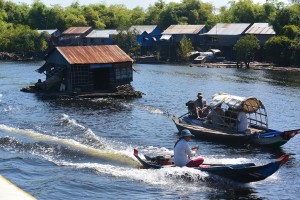 A floating house being towed to deeper water through a village of stilted houses
A floating house being towed to deeper water through a village of stilted houses
A fat pelican sat on the porch of a floating house. An unhappy monkey ran around on a chain in the full sun on a bamboo fishing platform and a full grown otter seemed ok as it scampered round the girl who held it’s leash.
 The stilted houses lining the still flooded banks of the middle Sangke River
The stilted houses lining the still flooded banks of the middle Sangke River
Telephone masts were visible in the distance. Riverbanks rose above the water and motorbikes parked beside houses. We’d reached the upper Sangke.
Beautifully painted pagodas in stark contrast to Cham mosques. Elegant stilted wooden houses with tiled roofs between sugar palm and kapok trees.
 A pagoda on the riverbank not far from Battambang
A pagoda on the riverbank not far from Battambang
Lena and Sebastian safely delivered to their garden enclave in Phum Wat Kor upstream of the town, I breathed a sigh of relief as the extra hot, double shot latte created by Chenda was placed on the little wooden table in front of me at Knyei Cafe.
Twice cooked beef with Seb and Lena at Jaan Bai cooking school restaurant then Jamesons and bed.
Weddingitis had infected the town and the Seng Hout Hotel where we’d booked to stay had a particularly virulent attack so we kept on going to find another bland box like building with half the Cardamon Forest used to make the furniture but ice cool rooms with no aesthetic distractions to sleep.
Day 3 The Battambang bicycle tour of the city with San.
First stop gold, bras, wigs, fruit, meat & fish, the crammed Psa Thmei or new market, built by the French.
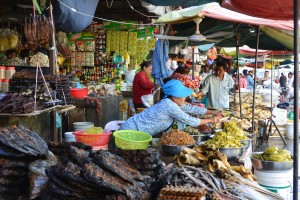 Psa Thmei
Psa Thmei
We crossed the quayside and down the dry banks to the ferry man who took us across the river to the monk school at Bovil Pagoda.
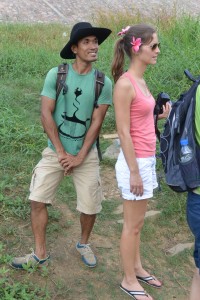
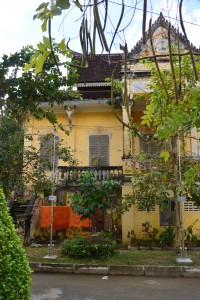 Manus & Lena crossing the river and a monk house at Bovil Pagoda
Manus & Lena crossing the river and a monk house at Bovil Pagoda
Singing rang out from the Catholic Church, which had the enthusiasm of an American black baptist congregation not the stilted formality of a Catholic communion. Time was getting short and the Bamboo Train beckoned so we had to forgo the black man in the middle of the road, another of Battambang’s attractions.
Giant wood spiders had weaved their webs over the rail tracks. The view extended across bright green rice fields to Phnom (hill) Sampeou in the distance.
A one-way system, lift off the bamboo platform, remove the axles and let the oncoming norrie through before putting it back together again.
 Nick (left), Lena & Sebastian on board a norrie
Nick (left), Lena & Sebastian on board a norrie

by Nick | Aug 6, 2019 | Angkor, Blog, Kayak
Background
The rise and fall of the Angkorian Empire, which lasted nearly 600 years from the 9thto the 14th century, was centered in what is now Siem Reap Province, around its greatest religious monument Angkor Wat. The metropolis of Angkor comprising nearly a million people covered a thousand square kilometers servicing what remained the largest city in the world until London eclipsed it seven hundred years later.
 Angkor Thom Moat, one of the great waterways that maintained ground water below the temple and prevented subsidence
Angkor Thom Moat, one of the great waterways that maintained ground water below the temple and prevented subsidence
Key to the success of the civilization was the management of water in a region of inundation and drought. An elaborate system of canals and barays or reservoirs channeled water from the Kulen Hills to the North into the city bringing food security in the form of rice and flood mitigation during the monsoon.
The availability of water ensured that food went in and shit went out. Canals facilitated the construction of the temples conveying the stone from the quarries to the North. And the temples were built with defensive moats that maintained ground water levels preventing subsidence (as well as looking pretty).
 Runta Dev, the tunnel under the 8m high walls of Angkor Thom that channeled waste-water out of the city into the moat
Runta Dev, the tunnel under the 8m high walls of Angkor Thom that channeled waste-water out of the city into the moat
Just as water was the key to the empire’s success it is now thought to be instrumental in its decline. Not long after the death of the great king JVII in 1218 the kingdom was hit with a double whammy. First 30 years of drought followed by exceptional floods, which washed away the elaborate and sophisticated water management system that JVII in particular had built.
In recent years the importance of these systems has been recognized again as the massive increase in tourism has lead to ground water levels falling and the potential collapse of the temples. It is no coincidence that the best preserved are those with functioning moats.
One man has been championing the restoration of the Angkorian water management. His excellency Hang Peou now Director General of Apsara, the authority responsible for managing the UNESCO world heritage site, has overseen the construction of canals that channel the Siem Reap River into the North Baray, the moats of Preah Khan, Ankgor Thom and even Angkor Wat. Reducing the possibility of Siem Reap flooding as it did in 2011. And maintaining the ground water levels that prevent subsidence of the temples.
 Peou overseeing our progress up the North Baray Channel
Peou overseeing our progress up the North Baray Channel
These small matters aside obviously the most important function of Angkorian hydrology is to allow us to paddle through the Angkor Park, Cambodia’s best preserved 400 km2 of lowland mixed evergreen and deciduous forest.
 Peou and Jady with Buntha contemplating our adventure
Peou and Jady with Buntha contemplating our adventure
And so it was one Monday morning that Peou, then Director of Water Management at Apsara, facilitated by Jady, a consultant working with Apsara together with Buntha and myself kayaked through the heart of the Angkor Park. Jady and I had previously recce’d Peou’s canal so this time we didn’t get lost and anyway Peou knew the way, but – we hadn’t followed the river as it heads South to the city.
The current had cut deep into the soft ground leaving 7meter high banks that we had to scramble down with our kayaks and then awkwardly get in them*.
*Evidence of the destruction of JVII’s waterworks as floods washed away his canals and gouged deep scars through Angkor.
 Paddling down the Siem Reap River
Paddling down the Siem Reap River
A few fallen branches had accumulated enough flotsam and jetsam to block the river with no way through but a messy scramble. Jady and Buntha paved the way. Poeu and I made it easy.
There are 700 Angkorian structures inside the Angkor Park but only 180 of them can be called temples, they’re the ones with moats. These monumental stone edifices need solid ground for their structural integrity, without it they crumble to a pile of stones. Siem Reap is a built on a light sandy soil, water gives it substance, which is what the moats do for the temples.
A few hundred meters on either side there were no doubt bus loads of Asian tourists but here in the heart of Angkor we paddled passed explosions of bamboo erupting on either side. White-collared Kingfishers taunted Buntha to catch a photo. A Snake Eagle followed our progress from above, while a Shikra watched us with disinterest from a fallen branch. All manner of other birds sang from the trees on either side obliterating any thoughts of tourists or even other people.
We’d catered for 5 pax kayaking but one of the water management guys came along for the ride so the third kayak was one paddle power short and we had visions of Kosal, Jady’s assistant unable to move his shoulders for a month or 2. They’d had the sense to share the work and caught up beaming and claiming the big adventure.
Our driver had accumulated helpers by the time we reached the sluice gates at the French Bridge (confusingly built by Americans), who pulled us up the steep stairs to Peou and Jady’s vehicles.
It took a while to sink in that we had paddled through one of the wonders of the world, visited by 3 million people but seen none, instead thick riparian forest as if we were discovering it for the first time.
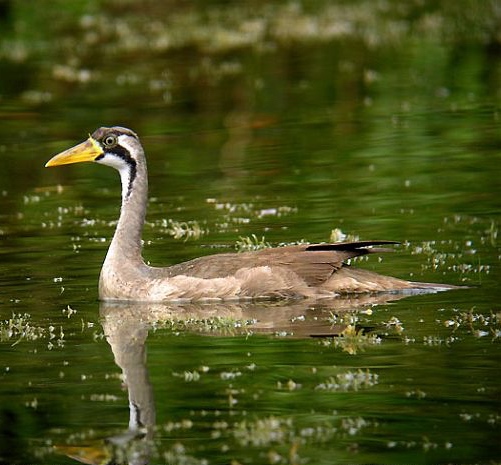
by Nick | Feb 22, 2019 | Blog, Cambodian Journeys, Kayak, Uncategorized
finfoot
1. The finfoot is Hatched
finfoot was born in Prek Toal and conceived in the myriad of marshy waterways that come and go with the flood and ebb of the lake across the floodplain.
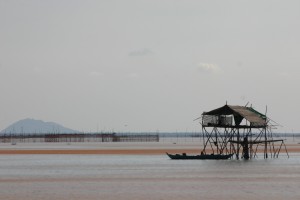
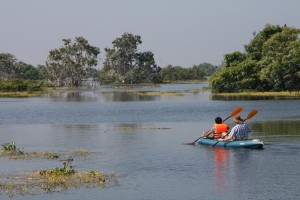 The Tonle Sap Lake during the ebb and Prek Toal Core Bird Reserve (below)
The Tonle Sap Lake during the ebb and Prek Toal Core Bird Reserve (below)
The Masked finfoot is a shy and reclusive water bird skulking in the marshy vegetation lining rivers and lakes. Spotting the bird is a rare and wonderful experience, which seemed a good enough reason to call our boat finfoot (masked is too difficult to pronounce).
 Early morning egrets in the Core Bird Reserve
Early morning egrets in the Core Bird Reserve
I came to Cambodia as a volunteer business advisor to a French NGO. The aim was to provide alternative livelihoods for the families we were working with on the lake. One of these livelihoods was ecotourism but they hadn’t got any guides, hence my first encounter as a bird guide with The Tonle Sap Lake and Prek Toal Core Bird Reserve.
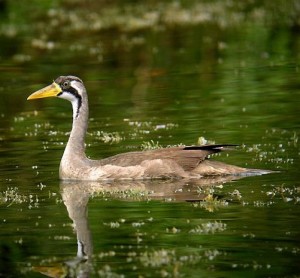 Masked Finfoot Hellopais personatus
Masked Finfoot Hellopais personatus
I didn’t know anything about either but was overwhelmed by the spectacle of the place.
Years spent in Cambodia passed by but my love affair with the lake remained. The phenomenal change driven by the backflow from the Mekong River was maybe reminiscent of the massive tidal zone around Jersey where I’d spent my childhood holidays. The extent of the lake and its inaccessibility, but not if I had a boat!
We’d got something to go on. The uber luxury resort Amansara had a boat called Amanbala. She was the brainchild of Sally the GM and a friend, so not to be copied while she was here but now she’s long gone, fair game.
We started with a wooden hull that seemed enormous and a rusting tangle of metal passing as an engine. It had towed a wedding platform from Prek Toal to the mouth of the fishing channel that leads to Maichrey when we staged the Bill Bensley Boat Races.
The message from our Thai business partners was full steam ahead, just put a business proposal together. So Buntha and I set off for Prek Toal. Buntha’s brother in law, the BiL, in more prosperous times had been a fish merchant as well as crocodile farmer. Moored behind his house was the hull. Once a container for transporting fish across the lake to Chong Khneas where some of the cargo made it to Thailand or Vietnam, while the rest rotted back to where it came from.
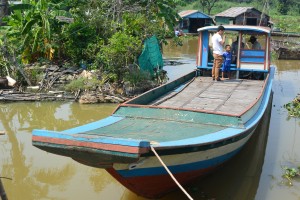 finfoot as it was behind the BiL’s house
finfoot as it was behind the BiL’s house
The BiL connected a big battery to the engine, turned a key beside the Camry steering wheel and the machine roared to life. We nosed round the Chheang collection of floating houses into the main channel. The boat was steered by ropes connected to a long tailed propeller shaft that slowly shifted it in the desired direction. There was no cover or sound proofing but the powerful sound of the big V6 engine was infinitely preferable to the minding numbing cacophony of the 2 strokes that drove the fiberglass long-tails screaming through the village.
Safely away from where our wake could do no more than shake a floating carpet of vegetation, the BiL pushed forward the throttle and the boat took off! The distant lake rapidly loomed large as we almost planed towards it. Two tons of solid wood doesn’t exactly lend itself to planing. The fuel gauge if we’d had one would have been spinning as litres of diesel exploded in the cylinders.
That was last year – 2017, when the lake reached its zenith. This year – 2018, as the water and our guests receded my focus returned to the boat. I put the requested proposal together for our business partners and waited for the green light but after umpteen revisions the light went orange and finally nothing at all.
The dry season window was evaporating when the boat builder could work all day, and most important the next tourist season looming.
I was back in the UK and weary with the sound of my own enthusiasm coming to nothing so the project stalled. Skip a month to Menorca, a weekend away with Laura an industry friend and her pal Duncan. ‘Tell us about your boat,’ they said so I did. ‘We’ll give you 25% – each.’ Ok so the projects incubating. ‘I will too,’ said my brother and the egg was on its way. Another investor in Siem Reap had agreed to 25% but that was talk so the last share became mine.
‘Buntha what’s happening with the boat?’ Was nearly the first question I asked when I got off the airplane from the UK, ‘nothing Bong,’ ‘well let’s make it happen.’ So we did. Mr fixit AKA Buntha found the boat builder at the tourist port of Chong Khneas, who’d built the Amanbala for Amansara.
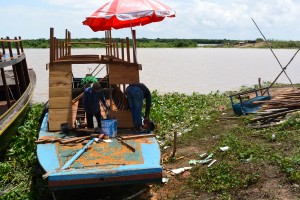
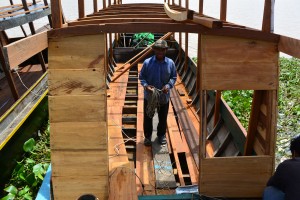
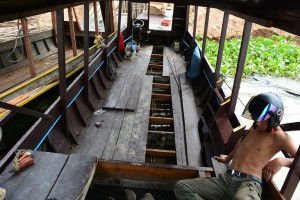
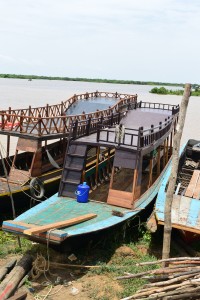 The metamorphosis of finfoot
The metamorphosis of finfoot
We forced our way through the tourist port, ‘not come here,’ the check point charlie ordered. ‘I’m not a tourist, I’m having a boat built.’ My Khmer didn’t cut any ice, I was white and therefor a tourist. I sat and glowered at him until the boat builder fetched me to see what would become a finfoot. We agreed a price, paid him something to show we were serious and that was actually that. Weekly visits to watch the metamorphosis of the bare wooden bones into finfoot went incredibly smoothly such that within a couple of months she was born.
2. finfoot flies
Our Team together with Joni, the GM of Treeline, friend and witness went to Chong Khneas as apparent tourists. Well that’s how Joni & I appeared, the rest are Khmer. We were herded down the gangplank onto the boarding platform and whichever tourist boat and disinterested driver we were to be allocated with. ‘We have a boat,’ I dismissed some tout having spied Heang our captain and finfoot moored and ready, then with a huge surge of pride stepped onboard.
finfoot powered across the floodplain with its big six cylinder lorry engine. Out on the open lake I took the wheel, opened the throttle and felt a surge of oomph. There was still another 30% to go. Our direction towards the forest was slightly disconcerting, I thought as I tried with no effect to correct it. Heang you’d better takeover, I suggested. It steers a little to the right. ‘Yes Bong,’ as if to say that’s why I’m the captain.

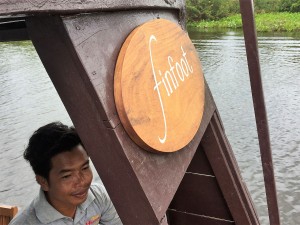 My efforts as Captain and Heang correcting them
My efforts as Captain and Heang correcting them
We moored at the mouth of the Maichrey channel, opened a bottle or two of Prosecco and took self-congratulatory photos.
The Team felt good and on the way back Lors was trying to engage Joni with the usual Khmer chat up line of why aren’t you married, not known for its subtlety. Grasping that the approach wasn’t going well he changed the subject. ‘How do you spell biopsy Nick?’ Sadly his mum had a breast tumor. Tiger grinning, ‘how do you spell f – – – Nick?’ ‘Not sure Tiger, ask Joni,’ even Lors laughed.
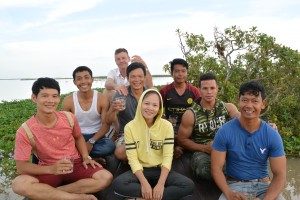 The Team (left to right) Bunthy, Tiger, Me, Buntha, Sreymom, Heang, Lors & Ra
The Team (left to right) Bunthy, Tiger, Me, Buntha, Sreymom, Heang, Lors & Ra
I wanted a space where Dean our partner in cocktails and canapés could work his magic so I commissioned Oyen the cabinetmaker to make a bar with an inset sink behind. Dean had to see it so just before setting off to the UK, Dean & Buntha together with Tiger & I launched our kayaks behind Phnom Kraum and paddled 10km to where the Maichrey Boat Station should be.
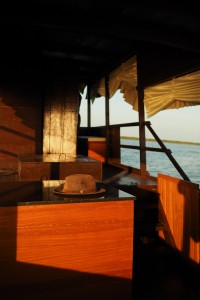
Deans bar
It started this year with a dam across the Mekong collapsing in Laos just North of the border with Cambodia. The surge of water that flooded down the river kicked off the backflow up the Tonle Sap River, which in turn flows into the Tonle Sap Lake. Heavy monsoonal rains filled the tributaries adding to the tsunami of water that was swelling the lake near to where it had risen in 2011. We glided across what was and soon will be again the semi-swampy floodplain straight to the boat station except the road was now flooded and the tourist boats were moored in the grounds of the local pagoda, usually a kilometer away. Tiger reappeared with a cold beer, my hero then the van bearing our guests and Dean’s cocktails arrived.
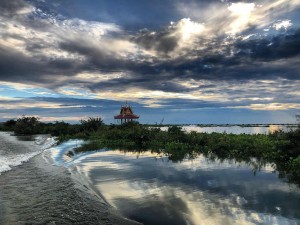 Naida’s IPhone photograph of the lake as we headed back to the pagoda
Naida’s IPhone photograph of the lake as we headed back to the pagoda
Moored behind a semi-submerged tree, we finished Dean’s cocktails as the sun sank through strata of cloud. Then Naida and the boys moved onto neat gin. We’d run out of tonic.
3. The final fit-out
Yes, yes, yes, said the fabric lady, when I explained that we wanted her unsightly but protective plastic curtains rolled up and wrapped in our beige canvas. The result was reminiscent of a 1970’s B&B in Aberystwyth and I should know, I’d lived in one! We’d also commissioned a canopy for the top deck to shade the mattresses she was going to make. The canopy remained elusive and the mattresses bore no relation to the space where they were to fit. She the fabric lady had sent someone to fit it all out but I don’t think they could count and I had to pay for the changes as she’d got our material that we’d sourced from Australia.
Meanwhile Oyen the cabinetmaker had finished everything he said he would by the time he said, though his daybed collapsed when he sat on it (he quickly came back to fix it). A ships wheel not the steering wheel of a Toyota Camry, the usual method of changing direction for most boats on the lake. I’d managed to find one at a ships chandler in Newhaven, Sussex along with the LED lights we needed for our sunset cocktail trips.
October last year I was back in the UK having one of our weekly Skype calls with Buntha. ‘Bong I’ve got good news and bad,’ or words to that effect. ‘Yes?’ ‘Well which?’ ‘Bad news,’ ‘the engines broke,’ ‘go on,’ I said, just in case you’ve lost the thread of this conversation. As soon as the subject gets technical English ceases to be an effective vector for communication. ‘So what’s plan B?’ I asked. One of the great things about Buntha is he has plan B’s. ‘I’m going on holiday.’ He didn’t actually say that but that’s what happened. He and the mechanic first went to Battambang no luck then to Phnom Penh. Bingo they got the required widget, something to do with the gearbox, and returned. Widget cost $250, traveling costs $250, fixed engine priceless and $900 cheaper than the ‘Bong it’s going to cost $1500.
4. Finfoot adventures
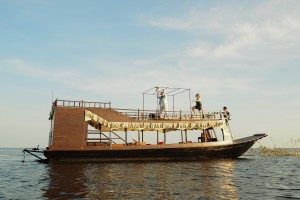
Stephanie and Jules from Bangkok together with Manus & I photographed by Serey and spoiled by frilly curtains
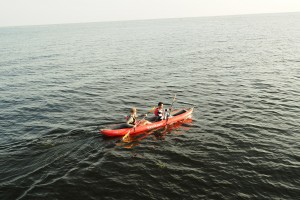

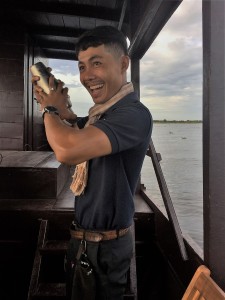 Christian + partner with Tommy on the top deck while Tiger mixes martinis by the bar
Christian + partner with Tommy on the top deck while Tiger mixes martinis by the bar
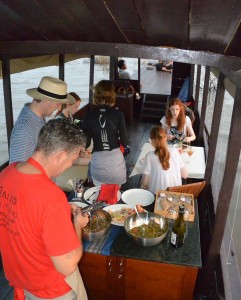 Christmas eve BBQ on board (you can just notice the correct curtains)
Christmas eve BBQ on board (you can just notice the correct curtains)
Our finfoot adventures had been piling up since that happy day we set off on our maiden voyage. It had been a hard week, the constant stress of our impending Smexit (a legal separation from our business partners) and a whole host of other obstacles real or imagined. We needed an excuse to get out of the office.
Manus uncharacteristically turned up on time so we; Buntha, Ra, Lors, Jin and Tiger with Manus set off to recce a big gay wedding party booked for next month.
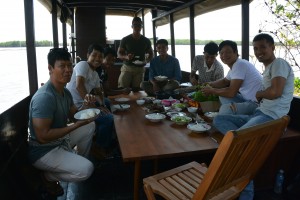 Left to right; Ra, Tiger, Heang, Lors, Jin, Doitch (our van driver), Buntha and Manus
Left to right; Ra, Tiger, Heang, Lors, Jin, Doitch (our van driver), Buntha and Manus
The context was Bill Bensley’s Boat Races in 2013 https://indochineex.com/blog/bill-bensley-boat-races-indochine-exploration
We had towed a wedding platform 15km from Prek Toal to Maichrey. His staff raced traditional water festival racing boats, while our muscle boys, ten of them including Manus, paddled Bill’s inner circle between the racing boats. A photo of Little Tee (left in 2013) and his biceps sold the trip this time so a newly married gay couple will use us to set up a party, with muscle boys on a platform at the edge of the lake.
The issue was the platform we’d used before had sunk when they drove a Caterpillar earthmover on it, so our mission today was to find another one. A job for the Sisters of Mercy and their volleyball court, unfortunately it was holding up the school, which wouldalso sink if we towed it away. Buntha had yet to come up with plan B.
Lors had a chicken smoking on the BBQ, Ra laid the table, Tiger took his shirt off, Jin blended into the background, Buntha sorted out the Sisters of Mercy while I relaxed with Manus and thought about our next adventure, a night on the lake with Manus on finfoot.
‘I want to sleep on the boat,’ Manus told me, and so did I but customers got in the way until the staff lunch.
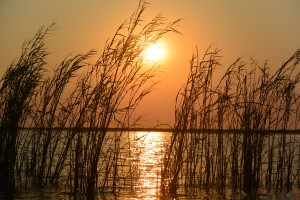
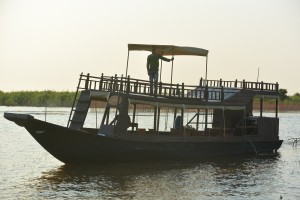 Sunset on The Tonle Sap Lake
Sunset on The Tonle Sap Lake
Upstairs or downstairs was the question. Cool with a view was the answer until I thought about falling off when I need to piss in the middle of the night so we strung up a mosquito net above the downstairs daybed.
Our rival operator as in David and Goliath, where we play the role of David, had kindly constructed and conveniently situated a small platform where the Maichrey Channel meets the Tonle Sap Lake.
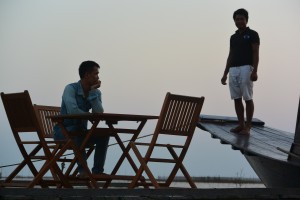 Manus on Goliath’s platform and Heang on the prow of finfoot
Manus on Goliath’s platform and Heang on the prow of finfoot
Heang moored finfoot alongside and I set off in a kayak to watch the sun sink into the Lake. The fishing season has started so the lakeshore is fringed with a maze of fishing nets designed to catch fish, not kayaks presumably. It was a puzzle how to avoid being funneled towards the trap where the unfortunate fish end their life’s journey.A few weeks ago quiet would have settled on the still waters as the sun sank now the staccato clap of 2 stroke engines reverberated as the fishing boys took watch.
A golden path lead from the West to finfoot and our platform for the night, where Manus had a set up a table and chairs. Heang was cooking. I’d forgotten any oil so he was braising our chicken in Cambodia beer, in the meantime I’d bought a bottle of champagne.
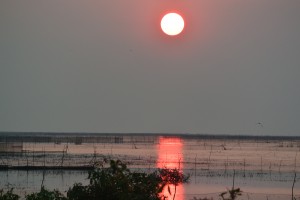 February sunrise over the Lake
February sunrise over the Lake
Heang and Manus sat on the platform as dusk descended and I popped the cork on a bottle of Moet. Manus likes champagne and so unfortunately did Heang, which meant there was a little too much sharing and not enough beer afterwards because it had been poured on the chicken!
It was cool so Manus and I curled up together. The precautionary Valium induced a soothing torpor little penetrated by the predawn clatter of fishing boats. Manus sweetly bought me a mug of tea when I woke and we watched the sunrise through the fishing fences from the East.
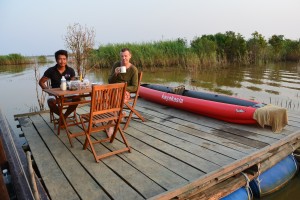 Breakfast on the Lake
Breakfast on the Lake
A couple of coffee’s later we reluctantly headed back. We’d missed the sweet spot when the lake’s high and the fishermen are back in the village mending their nets but it was still a beautiful experience.
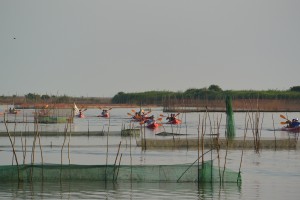
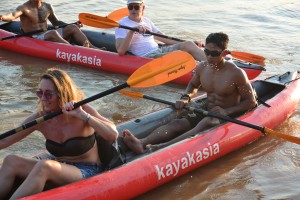
Philip and Stefan’s wedding party a couple of weeks later amongst the fishing fences and Mali the muscle boy with one of the guests
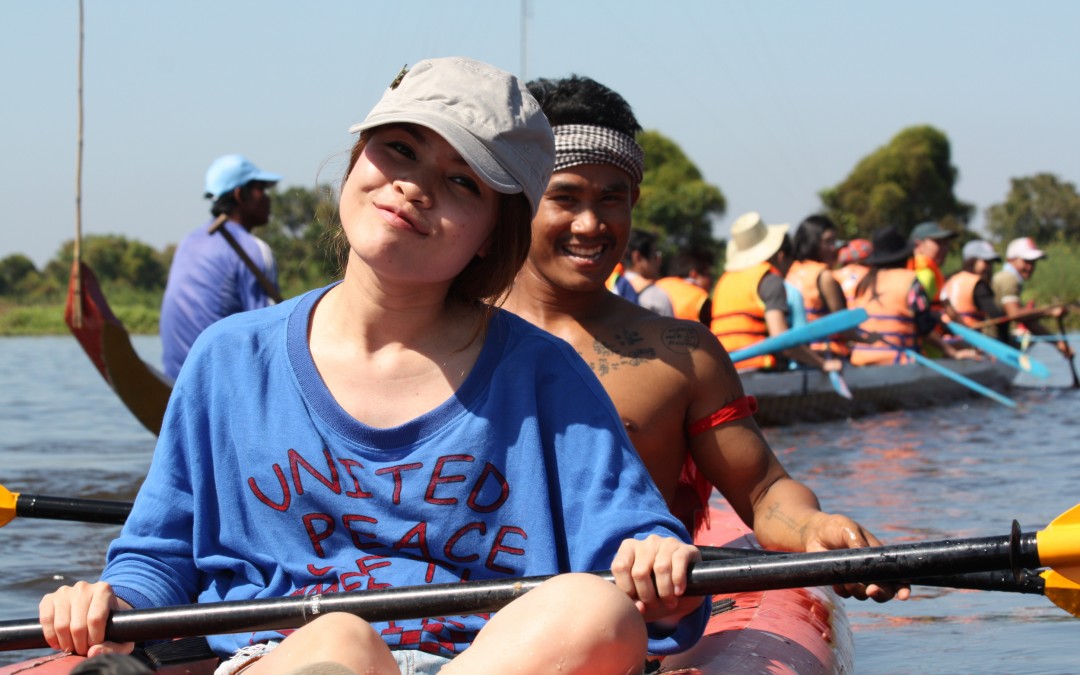
by Nick | Jan 1, 2019 | Blog, Kayak
The Bill Bensley Boat Races by Indochine Exploration
‘Nick I’ve got an amazing booking for you,’ said Christian the GM of Shinta Mani. ‘That’s great, what?’ I replied a little apprehensive knowing Christian. ‘Kayak,’ ‘Ok how many?’ ‘120’ ‘We can’t do it.’ ‘Why are you always so negative,’ Christian mocked. ‘We don’t have 120 kayaks. There aren’t 120 kayaks in Cambodia,’ ‘You’ll think of something,’ Christian reassured.
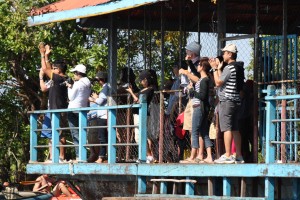
The Racing Platform
Every year Cambodia celebrates the reverse flow of the Tonle Sap River and the flood of The Tonle Sap Lake, with a water festival called Bon Om Teuk.
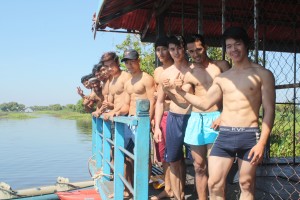
The Welcome Committee
In Phnom Penh over 400 fifty man traditional Khmer water festival boats race down the river watched over by the King. The celebration is repeated on rivers and lakes throughout Cambodia including Siem Reap, with smaller twenty man boats. The inspiration flashed through my brain in bed that night, a light bulb moment! What say we organise our own water festival? Christian loved the idea and so the Indochine Exploration or Bill Bensley Boat Races were born.
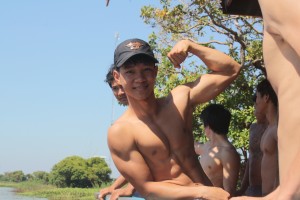
Little Tee
Making the idea a reality was a little harder:
- Where would we get the boats from? – Buntha charged around the pagodas of Siem Reap.
- Where would we race away from the covetous eye of the authorities? – Buntha went to see the Maichrey police and commune chief.
- What would we race from? – Buntha arranged to tow the wedding platform across the lake from Prek Toal 20km away.
- How would we get there? – We hired 3 big buses and 10 local motorboats.
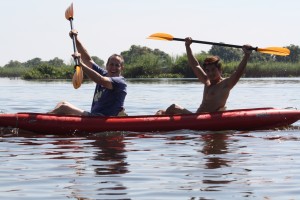
Bill and Tiger
‘Oh and Nick we want muscle boys,’ added Christian so I had the onerous task of choosing 10 chiselled young men from my gym.
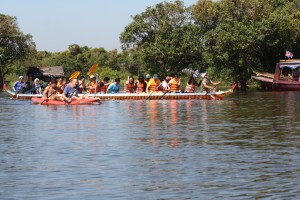
Getting Ready for the First Heat
Our guests were the 120 staff from the Bill Bensley design studios in Bangkok, who’d been on the piss the night before and were reduced in number to 80 and somewhat subdued, excepting Bill. I tried to explain what we were going to do. That most of them didn’t speak English might have had something to do with it. Our buses pulled up at the Maichrey boat station where our fleet was waiting. I sensed their interest start to overtake the collective hangover as we motored past the little hilltop pagoda still with its clutch of attendant floating houses. We chugged in convoy down the narrow channel that cuts though the vegetation while the lake is full. Storks wheeled overhead and kingfishers darted from overhanging branches.
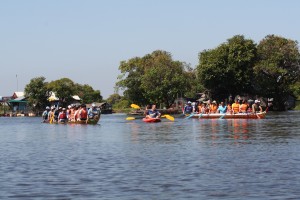
The Pink and Blue Team Race
We spied the race platform tied to the trees near the open lake and as we came closer WOW!! Whatever side of the sexual fence you sit, they were gorgeous. Clad only in shorts the full extent of the boys physiques were revealed much to the incredulity of the guests.
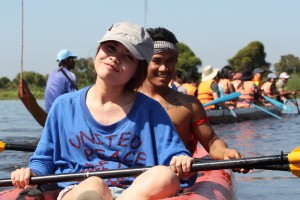
An Indochine Exploration Chauffeur
Chaos ensued made worse by me on the megaphone as we tried to assign all present into teams until I found out that they didn’t speak English and the message finally got through that they already had teams so Pink and Blue were first to race.
Making the assumption that an eskimo roll wasn’t possible in a Khmer racing boat an imminent capsize seemed inevitable as they boarded but amazingly settled 2 abreast they paddled the short way to where our Tony was waiting with his whistle in a motorboat at the start point.
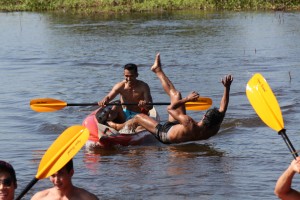
A few beers and some rice wine later
Meanwhile our muscle boys waited beside their kayaks until Bill bagged Tiger then Taylor took Little Tee. ‘I need to take photos Nick.’ ‘Hmmm I thought as she settled snugly behind his rippled back.
The races had started – oohps. I fumbled for my phone and clicked on the stop clock. They’d got it! A rhythm of ‘Oi Oi Oi!!’ to power their strokes drifted across the water. ‘Blue!’ I screamed through the megaphone. Then it was Orange and Green. ‘Green!’ I screamed.
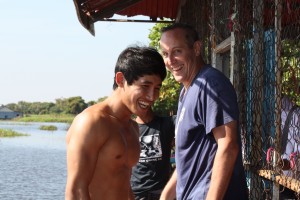
Bill and Big Tee
The muscle boys lubricated with a few beers and a bottle of rice wine (we found out later) had started to enjoy kayaking with or without the guests and in and out of the water. The same guests had relaxed and were chomping their way through Rinna’s buffet laid out on the wedding platform.
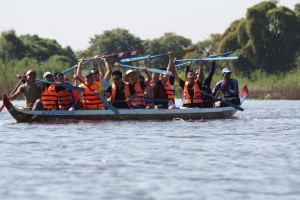
Blue – the Winning Team
The time had come for the grand final so Blue and Green, captained by Bill (with kayaking paddles) made their way to the start and somebody gave the go. A primeval collective grunt echoed across the lake as sophisticated designers found their caveman inside and strained on their paddles. ‘Blue, Blue, Blue!!! Yeay, we shrieked as they edged past Green (despite the kayaking paddles) and nudged the virtual finish line. Oohps no bonus this Christmas, Bill was Green.
Bill unnecessarily assisted by Tiger presented the winning team with 3 free nights at Shinta Mani and we bade them goodbye as they boarded the motorboats back to the buses and the hotel.
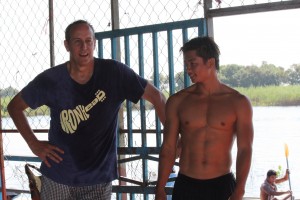
The grand prize – Tiger (presented by)
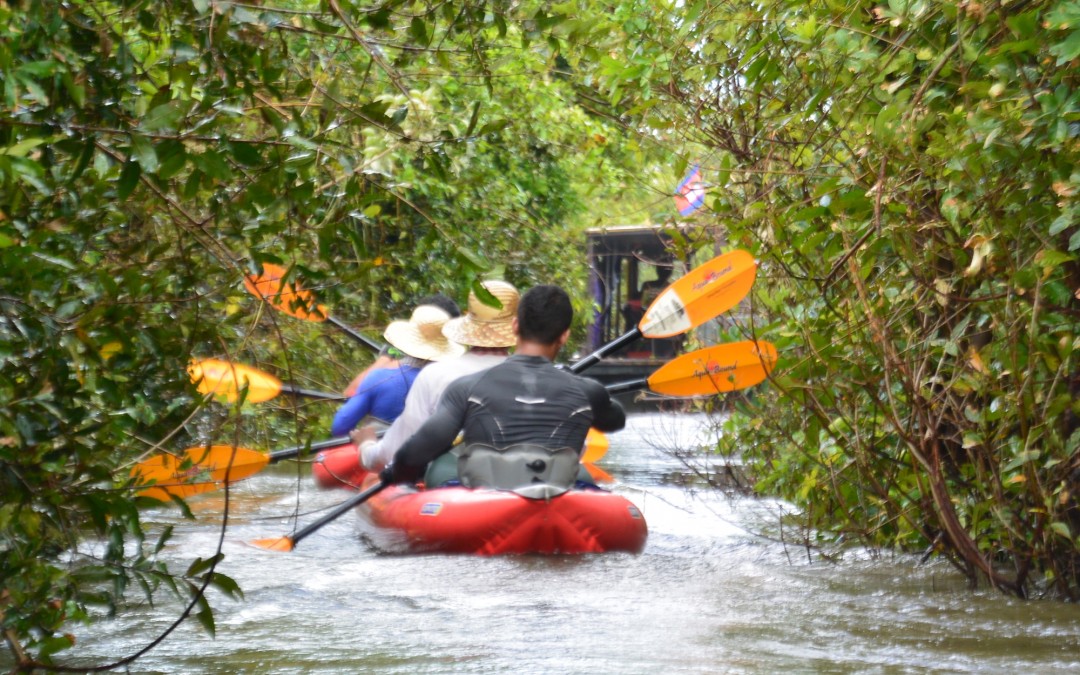
by Nick | Oct 26, 2017 | Blog, Kayak, Uncategorized
The Sangke River Kayak
This is the story of 5 men and their boats as they paddled across the floodplain of The Tonle Sap Great Lake from Battambang to Angkor.
We couldn’t let our muscles go to waste so despite we’d 3 days ahead of us and an unknown quantity of kilometers, the first objective on reaching Battambang was to firm up the engines that were going to drive us and find a gym.
Motors tuned in anticipation they now had to be fueled and this was where we split. The allure of Jaan Bai* was too strong and too expensive for the whole Team. ‘I’ll see you in the morning,’ I told them.
The next morning the call of coffee transcended our budget so we all congregated at Knyei** for a cup of arguably the best coffee in Asia before setting out on our voyage.
Prasat Prahoc*** lives up to its name, smelly – but it gave us a 10K head start.
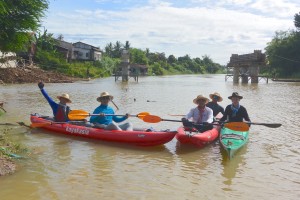 Setting off at Prasat Prahoc, from left to right; Buntha, Ra, Jin, Lors and Nick
Setting off at Prasat Prahoc, from left to right; Buntha, Ra, Jin, Lors and Nick
I had an unfair advantage but that seemed reasonable in light of a 30year disadvantage. The green hard hulled composite kayak cut though the water faster than our Gumotex war horses but given they had 2 prime paddlers per boat we were about matched.
* Jaan Bai; initially a David Thompson cooking school restaurant now run by Mark & Jose from Feelgood Coffee, also owners of **Knyei Café. Originally an NGO running cycling trips it now concentrates on amazing coffee in street 1 ½. *** Prahoc a Cambodian staple, fermented fish paste – an acquired taste.
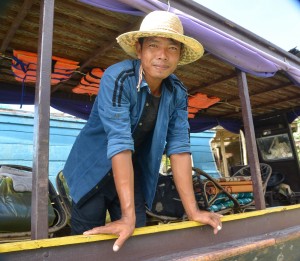
Heang (above) concerned, intelligent, efficient was waiting with his motorboat. Don’t get me wrong, we were going to kayak but we might as well do it comfortably, which meant keeping the beer cold.
The sun was shining (about 40 degrees and humid, a minor point). The river high and most important the current was heading our way.
To set the scene we were traveling downstream with the Sangke as it flowed from the Cardamom Mountains to the West, past Battambang and onto Prek Toal and the Tonle Sap Lake. Our mission was to follow its length albeit with a shortcut at the end to the floating village of Maichrey, our final destination.
 The Upper Sangke flowing through rural Battambong Province
The Upper Sangke flowing through rural Battambong Province
‘2 hours then adventure bars*’ I shouted. All was well excepting Jin who was car-sick the day before and quieter than usual. And water, whatever we drank sweated straight out, perhaps 5 liters that first day.
*Adventure Bars; a special recipe created by Dean from Miss Wong, granola bars in global demand but only available on Indochine Exploration Adventures.
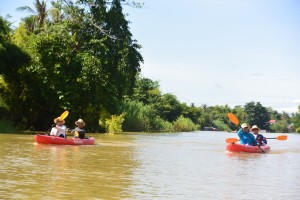
Buntha’s app told us we were averaging 7K such that after a couple of hours the river rose to meet the banks. The bamboo clumps and fruit trees thinned as we entered the middle Sangke, a region of endless rice fields.
I knew the route from the perspective of the Amanbala or whatever the motorboat I was traveling on at the time but from the kayak, under our own steam my relationship with the river was different and more connected.
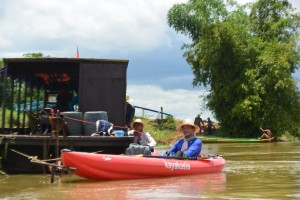 Adventure bars and coffee as we entered the middle Sangke, where stilted houses give way to floating villages.
Adventure bars and coffee as we entered the middle Sangke, where stilted houses give way to floating villages.
The current was cancelled by the rising lake, fast breaching the riverbanks and flooding the surrounding paddy fields. It felt like we were rising above the world to where the water met the sky.
On the patches that stood proud the trees were festooned with the strange fruit of weaver nests. Structures of woven grass attached to branches, which the birds entered like a diving bell from below. They sell these nests in Siem Reap, hanging them to their awnings thinking that the tourists will like the rustic impression they give but not caring for the birds that weaved them. It was cheerful to see them undisturbed next to the fishermen‘s huts.
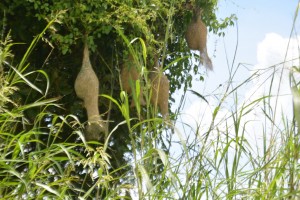 Weaver Bird nests
Weaver Bird nests
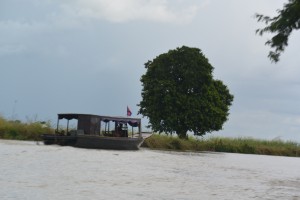 Into the Tonle Sap Floodplain
Into the Tonle Sap Floodplain
It’s true that an army marches on its stomach and now past 12 there was mutiny in the air, rice was need quickly. We found a perfect spot and tied up to the remnants of an old wooden house now mainly underwater and home to a family of rats. A snake swam across the river to join us for lunch.
Clouds ominous, the boys had the rice on the boil as the heavens opened and the rain poured down while Lors entertained us with his sexual encounters, apparently he doesn’t like sucking nipples. Other valuable advice was to follow the beaten path so you don’t have to cut the bush? Oh and we also learnt that he weighs 72kg before a shit and 70kg after.
 The encroaching lake
The encroaching lake
The rains have been good this year and the water was high so still with 2 months of flood to come we were able to cut off a 20K meander with a 5K cut through the seasonally flooded forest. An enchanted alley glistening from the recent rain, sunbeams splashing on shiny wet leaves.
I was thinking about Silver Langurs. Our hike through the Kulen Hills to the North of Siem Reap was set up to give the local villagers an incentive to protect the monkeys. But for all the talk honestly I wasn’t sure if I’d ever seen them. On queue, perched on a branch just 5 meters away was a Silver Langur and a few strokes further more brought me close enough to confirm.
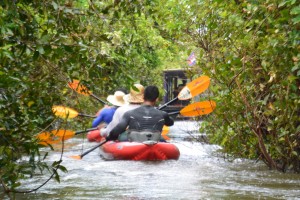 The shortcut, an enchanted alley cut through the seasonally flooded forest
The shortcut, an enchanted alley cut through the seasonally flooded forest
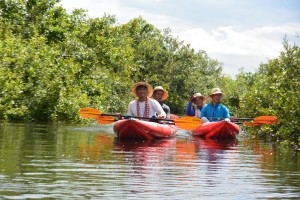
The birdsong beckoned but we weren’t the only ones taking advantage of the narrow channel. Most boats slowed as they came near, a few young idiots threw a wake over our Gumotex coming to an abrupt halt when they met Heang and his motorboat.
Phum Bakprea, the halfway point where the Sangke meets the Monkul Borey River. A water hyacinth jam, we could see the telephone masts of the village but 10m of compacted weed meant it could have been the moon. Of course Lors the machine that he is could heave his way through but the rest of us waited for Heang to tow us.
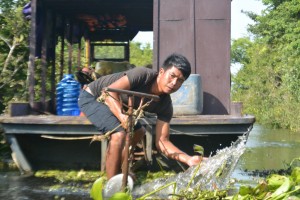 Heang towing us out of a hyacinth jam
Heang towing us out of a hyacinth jam
Heang threw a line to me and Buntha attached his rope to my tail, slowly we squeezed through the floating mat. The broad blades of his propellers were alarmingly close but after our recent battles see a water hyacinth workout, they were preferable to be being stuck.
Google Earth shows a road reaching the village in the dry season but for now its isolated in the The Tonle Sap floodplain. A river rendezvous where the tourist boats refuel on route to Siem Reap. A big sign advertised a Battambang boutique guesthouse complete with swimming pool somewhat at odds with the largest pool in South East Asia, where we were currently floating.
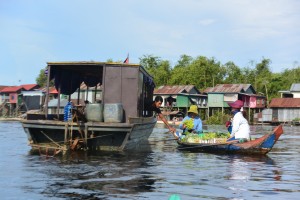 Phum Bakprea, picking up bananas
Phum Bakprea, picking up bananas
It was half past four, we’d been going since eight and were getting tired, a coconut stop. ‘Wat Chou Kmao 40 minutes,’ Heang told us. We could sleep with the monks at the pagoda.
Chased by rolling waves of angry grey clouds getting darker and darker pushing a wall of wind behind us we surfed down the river, flying in the face of the storm.
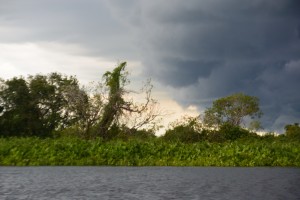 Chased by a storm down the river
Chased by a storm down the river
As the storm surge subsided we approached a village looking for a place to rest. Despite the statuesque youth in underpants, the thump of amplified base persuaded us to keep paddling. A little further on was an empty platform but for some nimbi- ish reason it was off limits so we wearily continued in the twilight.
A pale flicker of light bathed the river as we put forward our paddles after 10 hours and floated towards our mother-ship, where we were going to sleep that night.
The clear water was alive with fish minus one as Lors caught a half kilo catfish on a thin bamboo pole, which together with a bucket of snails that kept escaping was lunch for tomorrow. Compelled by hunger the team had rice pots boiling and were dicing and cutting vegetables and meat. Caught in a limbo of disconnected and contented exhaustion I looked on with a cold beer while they cooked supper and contemplated my paddling companions. Ra an old woman but eternally nice, Buntha smart as always, Jin the baby but never complaining, so full of goodness he should be on the front of a breakfast cereal packet and indestructible Lors. I felt extremely fortunate.
The boys were content to lie on mats. I had a mattress. Under mosquito nets we lay across the width of the boat. The heavy and humid air was contained by blinds hanging on either side with the aim of stopping us getting wet. The rain started just as we were dozing off.
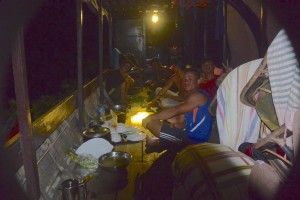 Lors and the boys cooking dinner.
Lors and the boys cooking dinner.
Attempting to sleep the volume increased and it started to seep through the covers slowly filling the boat lapping at my mattress by now more of a sponge. Heang turned on the bilge every hour ensuring that only glimpses of sleep were snatched. I must have drifted off as a pale dawn penetrated my Valium induced torpor.
Lors was the first thing I heard. ‘How many nights do you need to get by without sleep before you get tired?’ ‘What?’ ‘He means shut up,’ Buntha interpreted and handed me a hot mug of tea. Heang lifted the covers revealing the grey green river-scape and the next day seemed possible.
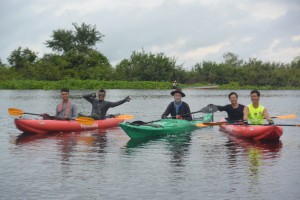 Setting off a little less enthusiastically on our second morning
Setting off a little less enthusiastically on our second morning
‘How far now Heang,’ we asked. ‘I think you do 55%,’ he replied rather too diplomatically. The prospect of another sodden night was enough for us to decide to try and make it back in one day.
The current had gone, the river was wide and meandering away from the prevailing Westerly wind that had propelled us the night before so we paddled by ourselves.
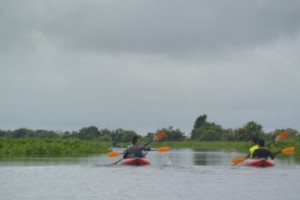 Heavy hanging grey clouds at least meant we weren’t being grilled by the sun.
Heavy hanging grey clouds at least meant we weren’t being grilled by the sun.
It was a good call to have stopped where we did, Wat Chou Kmau was another hour from where we had moored for the night.
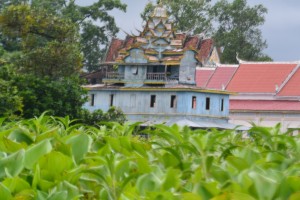
Heang was waiting after another 5km beside a pagoda in the center of a large stilted village.
The river was completely blocked by hyacinth so when we saw a seller boat heading off into the flooded forest on one side of the channel we reckoned they knew a way through. We followed and came out the other side, which was more than Heang managed and for some unfathomable reason he’d headed back towards Phum Bakprea. ‘Why don’t they clear it?’ I thought. Collective action for the benefit of all but it’s less effort to get a long tail with a reverberating 2 stroke and cut through alone – I answered myself.
Grey water under a grey sky, open stretches of river in shoulder aching straight lines between floating villages now the flood lasted longer than the ebb. Seasonally flooded forest fringed the river. A Black-shouldered Kite flew near an untidy nest of random twigs watched over by a Grey-headed Fish Eagle. I just made out a monkey on the far bank but too far away to tell what flavor, parakeets, pelican, duck.
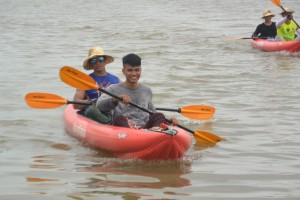 Lors and Jin towards the end
Lors and Jin towards the end
Another floating village where we waited for Heang who’d lost us in the water hyacinth, coffee and adventure bars, well done Dean.
Approaching our lunch stop at Kampong Prahoc we saw the 3 telephone masts of Prek Toal, visible from a long distance as it wasn’t K. Prahoc but another village 30 minutes the wrong side. Buntha had an excuse to go to Prek Toal, we didn’t but we ended up paddling there anyway. ‘Why didn’t we take the shortcut?’ I grumpily demanded. ‘Water hyacinth,’ mumbled Buntha. The excuse for everything, I thought but didn’t say.
The short cut to Maichrey an hours breeze with Jady a few weeks back but today a balance between general ache and the freedom of well just being free.
How many thousands, maybe millions of paddle strokes did we do? Shoulders aching, back in seizure, legs cramping, twenty hours in the kayaks and 80 kilometers paddled. I nearly cried when we got to the boat station at Maichrey.
‘So tired, ‘ Buntha said the first morning now a lifetime away, no stress, work and self irrelevant, just us Heang and the river.
 Lors, Heang, Nick, Ra and Jin at the end.
Lors, Heang, Nick, Ra and Jin at the end.

 Angkor Wat Moat
Angkor Wat Moat Runta Dev, the tunnel under the 8m high walls of Angkor Thom that channeled waste-water into the moat
Runta Dev, the tunnel under the 8m high walls of Angkor Thom that channeled waste-water into the moat Overseeing our progress up the North Baray Channel
Overseeing our progress up the North Baray Channel Paddling down the Siem Reap River
Paddling down the Siem Reap River  Contemplating our adventure
Contemplating our adventure

 Pit Viper in tree beside boat
Pit Viper in tree beside boat Seb and Lena setting off from their homestay
Seb and Lena setting off from their homestay Sunset over the Prek Toal Core Bird reserve
Sunset over the Prek Toal Core Bird reserve Dawn over Prek Toal
Dawn over Prek Toal

 The salapali or space for teaching of Wat Cheu Kmao
The salapali or space for teaching of Wat Cheu Kmao Grey-headed Fish Eagle
Grey-headed Fish Eagle A floating house being towed to deeper water through a village of stilted houses
A floating house being towed to deeper water through a village of stilted houses The stilted houses lining the still flooded banks of the middle Sangke River
The stilted houses lining the still flooded banks of the middle Sangke River A pagoda on the riverbank not far from Battambang
A pagoda on the riverbank not far from Battambang Psa Thmei
Psa Thmei
 Manus & Lena crossing the river and a monk house at Bovil Pagoda
Manus & Lena crossing the river and a monk house at Bovil Pagoda Nick (left), Lena & Sebastian on board a norrie
Nick (left), Lena & Sebastian on board a norrie
 Angkor Thom Moat, one of the great waterways that maintained ground water below the temple and prevented subsidence
Angkor Thom Moat, one of the great waterways that maintained ground water below the temple and prevented subsidence Runta Dev, the tunnel under the 8m high walls of Angkor Thom that channeled waste-water out of the city into the moat
Runta Dev, the tunnel under the 8m high walls of Angkor Thom that channeled waste-water out of the city into the moat Peou overseeing our progress up the North Baray Channel
Peou overseeing our progress up the North Baray Channel Peou and Jady with Buntha contemplating our adventure
Peou and Jady with Buntha contemplating our adventure Paddling down the Siem Reap River
Paddling down the Siem Reap River 

 The Tonle Sap Lake during the ebb and Prek Toal Core Bird Reserve (below)
The Tonle Sap Lake during the ebb and Prek Toal Core Bird Reserve (below) Early morning egrets in the Core Bird Reserve
Early morning egrets in the Core Bird Reserve Masked Finfoot Hellopais personatus
Masked Finfoot Hellopais personatus finfoot as it was behind the BiL’s house
finfoot as it was behind the BiL’s house


 The metamorphosis of finfoot
The metamorphosis of finfoot
 My efforts as Captain and Heang correcting them
My efforts as Captain and Heang correcting them The Team (left to right) Bunthy, Tiger, Me, Buntha, Sreymom, Heang, Lors & Ra
The Team (left to right) Bunthy, Tiger, Me, Buntha, Sreymom, Heang, Lors & Ra
 Naida’s IPhone photograph of the lake as we headed back to the pagoda
Naida’s IPhone photograph of the lake as we headed back to the pagoda


 Christian + partner with Tommy on the top deck while Tiger mixes martinis by the bar
Christian + partner with Tommy on the top deck while Tiger mixes martinis by the bar Christmas eve BBQ on board (you can just notice the correct curtains)
Christmas eve BBQ on board (you can just notice the correct curtains) Left to right; Ra, Tiger, Heang, Lors, Jin, Doitch (our van driver), Buntha and Manus
Left to right; Ra, Tiger, Heang, Lors, Jin, Doitch (our van driver), Buntha and Manus
 Sunset on The Tonle Sap Lake
Sunset on The Tonle Sap Lake Manus on Goliath’s platform and Heang on the prow of finfoot
Manus on Goliath’s platform and Heang on the prow of finfoot February sunrise over the Lake
February sunrise over the Lake Breakfast on the Lake
Breakfast on the Lake














 Setting off at Prasat Prahoc, from left to right; Buntha, Ra, Jin, Lors and Nick
Setting off at Prasat Prahoc, from left to right; Buntha, Ra, Jin, Lors and Nick
 The Upper Sangke flowing through rural Battambong Province
The Upper Sangke flowing through rural Battambong Province
 Adventure bars and coffee as we entered the middle Sangke, where stilted houses give way to floating villages.
Adventure bars and coffee as we entered the middle Sangke, where stilted houses give way to floating villages. Weaver Bird nests
Weaver Bird nests Into the Tonle Sap Floodplain
Into the Tonle Sap Floodplain The encroaching lake
The encroaching lake The shortcut, an enchanted alley cut through the seasonally flooded forest
The shortcut, an enchanted alley cut through the seasonally flooded forest
 Heang towing us out of a hyacinth jam
Heang towing us out of a hyacinth jam Phum Bakprea, picking up bananas
Phum Bakprea, picking up bananas Chased by a storm down the river
Chased by a storm down the river Lors and the boys cooking dinner.
Lors and the boys cooking dinner. Setting off a little less enthusiastically on our second morning
Setting off a little less enthusiastically on our second morning Heavy hanging grey clouds at least meant we weren’t being grilled by the sun.
Heavy hanging grey clouds at least meant we weren’t being grilled by the sun.
 Lors and Jin towards the end
Lors and Jin towards the end Lors, Heang, Nick, Ra and Jin at the end.
Lors, Heang, Nick, Ra and Jin at the end.